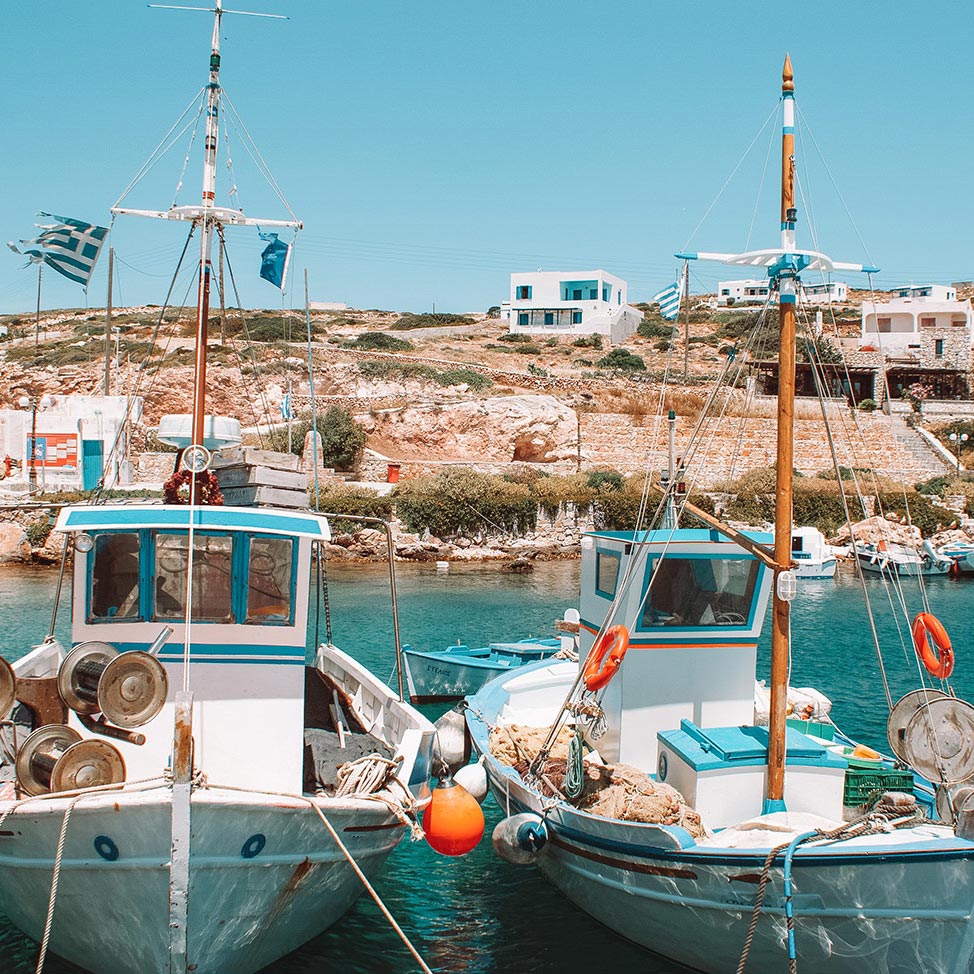
On the captivating island of Donoussa you will find mainly two things: wilderness and freedom. Time goes by slowly here, but no one seems to mind. And even the rooster crows in the middle of the day, for no apparent reason.
The locals will make you feel right at home and introduce you to their pace of life. After all, they were the ones that some years ago asked for … cicadas. Yeap, neither doctors nor teachers, but cicadas. You will love them.
From a fishing boat called “Enchantress” that takes you to remote beaches and caves, to untouched trails that lead to forgotten hamlets that travel you back in time, here is everything you need to know about the most secluded island of the Cyclades!

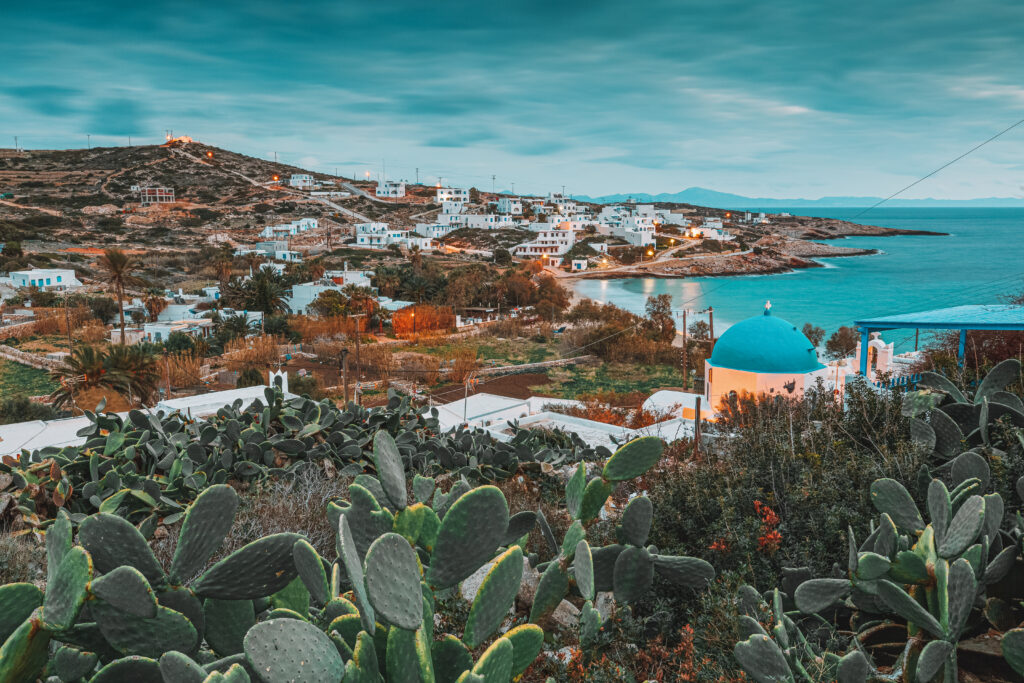
A Short History
The island where Dionysus, the god of wine, brought Ariadne to hide her from Theseus – according to Greek mythology – was once a place of exile and later a hideaway for pirates. Lots of names have been given to this tiny island: foreign sailors called it Stenosa or Spinosa, Vergulius referred to it as Viridem, due to its lush vegetation and green marble, it was later known as Denousa, and we now call it Donoussa, also spelled Donousa.
The name “Denousa” can be associated with a verb meaning “to moor” and is probably related to the great naval importance of the island as a stopover for ships that on their long voyages “moored” in its safe coves. According to other interpretations, the name comes from the god Dionysus or from the verb “dono” which is related either to earthquakes or to the jolts caused by the rough waves of the Aegean.
The richness of the Greek language…


September sees less crowds, mild weather, and the biggest religious festival on the island!
When to Visit
The summer months of July and August are when Donoussa sees crowds and temperature soar, tours and ferries are running full tilt, and accommodation prices are at premium rates. The island, however, is still off the beaten track and the beaches will never be too busy, with a great summer holiday vibe around.
During the shoulder season– late spring or early autumn, life comes to a standstill or at least turns its back on tourism, and this is when you’ll experience island life at its most potent. The weather is softer, the crowds are slimmer, the sea is a bit cool but more pleasant than you had hoped for, and you’ll see more wildflowers than you could have imagined. Be mindful, however, that domestic flights and island ferries have reduced schedules outside of the summer season.
Meltemia winds
One consideration for the timing of your visit is that Donoussa, as is the case with all the Cyclades, often gets frustratingly stormy, particularly in early spring and late autumn. Throughout much of July and August, the island is also affected by “meltemia” or “etesians”, strong dry winds that blow in the southern Aegean as northwesterlies. They are at their strongest in the afternoon and often die down at night, but sometimes meltemia winds last for days without a break. Delayed or canceled ferries are not uncommon, so leave yourself a day or two’s leeway.
The Festivals
Those familiar with Greece, have probably heard of “panigiria”, traditional festivals organized during the summer months mainly in the villages of the Greek islands and mainland, where the patron saint is celebrated.
The biggest one in all of Greece is arguably the Feast of the Virgin on August 15. In Donoussa, the celebration takes place at the small Church of Virgin Mary on the hilltop of the village with locals and tourists mingling as one.
Another great festival is the one held for the Exaltation of the Holy Cross. On the eve of September 14, a vesper takes place in the Church of Holy Cross, the island’s saint patron, and soon after, bread, wine, and raki are served alongside the traditional “patatato” in the churchyard. The feast goes on at the port, where you will dance to the rhythm of the violin.
Last but not least, on September 17 there is the feast of Saint Sofia in the quaint whitewashed church of the same name in the village of Mersini.
So, if you’re lucky, you’ll stumble on one of these celebrations. September is after all one of the best months to visit the island!


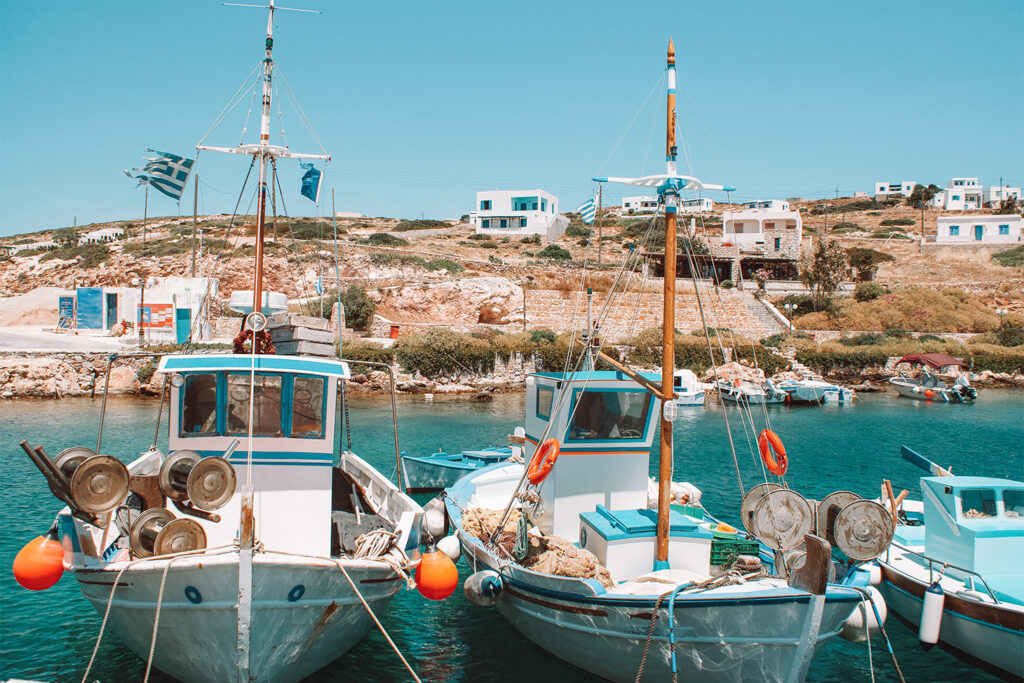
How to Get to Donoussa
Airports near Donoussa
There is no airport on the small island of Donoussa. The closest ones are located in Paros (PAS) and Naxos (JNX) and serve daily domestic flights from/to Athens. Of course, you can also catch a flight to the International Airport of Athens (ATH) and then head to the Port of Piraeus.
Ferry to Donoussa
Donoussa is connected by ferry to the Port of Piraeus, Paros, Naxos, the other Lesser Cyclades (Koufonissi, Iraklia, Schoinoussa), Amorgos, and Astypalaia. Depending on whether you are starting your journey from Athens or you are already hopping the Lesser Cyclades, you will reach Donoussa by conventional fast ferry or slow boat respectively. In any case, the ferry docking into the small quaint port of Stavros, surrounded by breakwaters, is an experience on its own!
Blue Star Naxos is a passenger ferry in the fleet of Blue Star Ferries, the biggest ferry company in Greece. It connects the port of Piraeus with Astypalaia, calling at the ports of Paros, Naxos, Donoussa, and Amorgos. During the summer, it reaches Donoussa every Monday, Wednesday, Friday, and Saturday in about 7 hours.
|Route: Piraeus – Paros – Naxos – Donoussa – Amorgos – Astypalaia
Express Skopelitis is a small local ferry that operates for more than 30 years, connecting its home port, Amorgos, with Donoussa, Koufonissi, Schoinoussa, Iraklia, and Naxos, all year round. The legendary ferry reaches Donoussa 3 times per week: Tuesday, Thursday, and Saturday during the summer season, and Monday, Wednesday, and Saturday during the rest of the year.
|Route: Amorgos – Donoussa – Koufonissi – Schoinoussa – Iraklia – Naxos



How to get around Donoussa
Donoussa is quite a small island with just one main road that starts from the port, continues east, and then ends at the northern part of the island after 12km. The transportation options may be limited but the walking trails are those that woo, with their destinations being exquisite coves and stunning vistas of an island-dappled Aegean. Off-season you can travel around the island only by taxi or private vehicle, but keep in mind that there is no gas station. During the summer, however, a minibus usually runs along the main island road and the shipping boat “Donoussa Magissa” sets sail for the island’s inlets and beaches.
Local Minibus: The bus departs from the port and calls at Kedros, Messaria, and Mersini before terminating at Kalotaritissa.
| Tel: (+30) 6932488529 | June to September, 6 times per day
Donoussa Magissa Sea Taxi: From the village of Stavros, the traditional fishing boat “Donoussa Magissa” – Magissa translates to “Enchantress” – sets sail for the island’s remote beaches and attractions. The boat sails at 10:30 and usually takes you to Kedros, Livadi, and Fokospilia, and, weather permitting, around the island (Kalotaritissa, Tihos Cave, Makares inlets).
| Tel: (+30) 6944203441 |June to September – weather dependent, always check at the port for the exact route
Taxi – Tel: (+30) 6971774696



The Villages of Donoussa
Quaint alleys with beautiful Cycladic architecture, tiny white houses with their green and blue shutters, whitewashed churches, and flower-filled courtyards… These, along with many goats and chickens, are what you will find as you make your way to the island’s four settlements.
Stavros Village
Island life centers on the picturesque port settlement of Stavros – also known to locals as Kampos, founded by the first inhabitants who arrived on the island from Amorgos. Spread out behind the harbor and the village beach, this is where you will find the majority of accommodation establishments, as well as a few nice tavernas and bars, and a mini-market. In addition, both the local bus and the sea taxi to the island’s beaches depart from Stavros, making it probably the best place to stay if you want to make your transport easy.
|Attractions: Timios Stavros Church, Panagitsa Church
| Beaches: Stavros
| Hikes: Trail #1, Trail #5
Messaria Village (Haravgi)
Messaria is an almost uninhabited farming hamlet in the middle of the southern part of the island. With more hens and goats in the streets than people, it only livens up during the summer months when trekkers follow the island’s footpaths. Make a stop here to admire the panoramic view of the Aegean and take a walk around the picturesque village with its traditional stone houses. You can also follow the trail towards the old windmills and then head down to the pebbly beach of Vathi Limenari with the ruins of a settlement from the Geometric Period.
|Attractions: Upper and Lower Windmills, Ruins of a Geometric Settlement
| Beaches: Vathi Limenari
| Hikes: Trail #2, Trail to Vathi Limenari

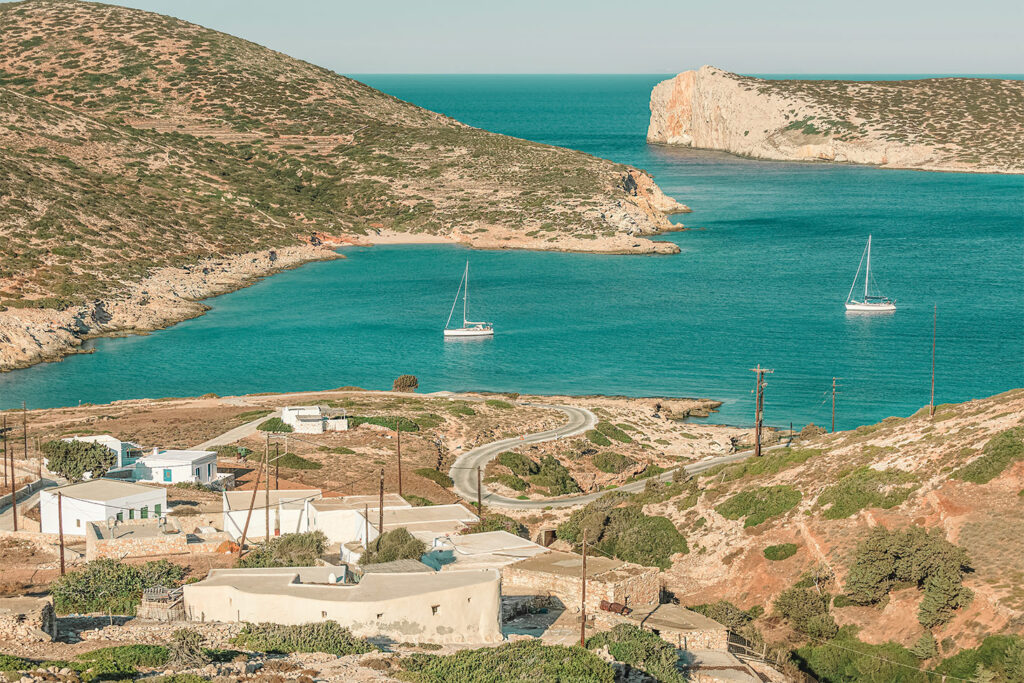
Kalotaritissa
The tiny quaint hamlet of Kalotaritissa with its low stone houses is located at the northeast end of the island. To get there, you can either take the fishing boat or jump on the local minibus. For an attractive hike head inland from Stavros to Pappas, the island’s highest point, from where a valley drops down rapidly to the village (Trail #1). Here you will find an enchanting bay with three beaches and just above them, a traditional tavern serving local specialties.
| Beaches: Vlycho, Sapounohoma, Mesa Ammos or Trypyti
| Hikes: Trail #1
Mersini Village
The enchanting agricultural village of Mersini, built on a green hillside on the southwest of the island will surprise you with its fauna. Not following the usual Cycladic pattern, it’s an oasis of orchards with apricot and peach trees, vegetable gardens, and a welcome spring beneath a centenarian plane tree, the island’s only running water. Admire the view from the chapel of Agia Sofia, and enjoy a meal at one of the village’s traditional taverns. A nearby path leads down to Livadi, an idyllic white-sand beach with tamarisks for shade, and the remote Fikio beach, a small natural cove.
|Attractions: Church of Agia Sofia
|Beaches: Livadi, Fikio
|Hikes: Trail #3


Try to be there during a “panigiri”, when the patron saint is celebrated.
Attractions
Donoussa may be a small island without any major attractions that will leave you speechless. Nonetheless, its sea caves, churches, and windmills tell a different, more interesting story: that of the everyday life of a tiny remote Cycladic island.
Cycladic Churches
Small churches of traditional Cycladic architecture – but each with its own distinct character – adorn the island’s landscape.
In the village of Stavros, the Church of Holy Cross (Timios Stavros), to which the village owes its name, is distinguished for its beautiful blue dome and its tall bell tower. The original church was constructed at the end of 1800 but fell to ruins with the passage of time and it was rebuilt in 1902 where it currently stands.
On the hilltop of Stavros, you will find the twin churches of the Virgin Mary and St. John, a pair of traditional 19th-century chapels joined by a small bell tower. A visit late in the afternoon will reward you with a mesmerizing view as the sun sinks behind the island of Naxos.
Another emerald of the Cycladic architecture is the picturesque Chapel of Agia Sofia on a hill above the village of Mersini. Make a stop here to cool off with some natural spring water in the shade of the giant plane tree, as you let your gaze travel across the sea as far as the island of Amorgos.
Isolated Caves
Donoussa is a wild and remote island and so are its exquisite sea caves: Fokospilia and Tihos. Both of them are accessible only by the fishing boat “Donoussa Magissa” that makes round-the-island trips, setting sail from the village of Stavros.
First, prepare to be enchanted by the majestic beauty of Fokospilia, located on the eastern side of the island, beneath the steep cliffs of the Cape of Moschona. As its name – which translates as “Cave of Seals” – indicates, it used to be a marine habitat of the Mediterranean monk seal. The rocky landscape and stunning emerald waters make it an ideal location for diving and exploration.
Just across the island, nestled on its northwest part between the capes of Ksilobatis and Aspros Kavos, there is the Tihos Cave (Cave of the Wall). Swim in its crystal-clear waters and pass through the curved chamber with its impressive rocks and stalactites hanging from the roof.
Windmills
The Upper and Lower Windmills close to the village of Messaria used to grind migadi, a mixture of wheat and barley, to produce flour. Unfortunately, they are not in operation anymore and neither are they well preserved. Nevertheless, they bear witness to the past and make for a scenic spot to take photographs on your way to Vathi Limenari beach.


Stavros Village Beach
the Beaches of donoussa
Stavros
Situated next to the port of Donoussa and surrounded by tourist amenities, Stavros is arguably the island’s most crowded beach. It is ideal for families thanks to the shallow waters, the sandy beach, and the natural shade provided by tamarind trees.
Vathi Limenari
Vathi Limenari, once a pirate port, is a small pebbly beach, where you will also find the ruins of a settlement from the Geometric period. An ideal beach for those seeking a private spot, it is only accessible by boat, departing from Stavros, or by following the steep path down from the old windmills. To get to the Lower Windmill, either follow the path from Kedros beach (Trail #4) or hike down there from the village of Messaria.

Livadi Beach
Livadi
With fine white sand, waters in every shade of blue and green, and natural shade provided by tamarisk trees, the long nudist beach of Livadi is probably the most beautiful one on the island. It is a 20 minutes’ hike from the village of Mersini or a short but scenic boat ride from the port of Stavros.
Fikio
Surrounded by a rocky landscape, this small sandy cove with emerald waters is a paradise for lovers of seclusion and contemplation. Remotely located next to the beach of Livadi, it can be reached by hiking along the trail that starts from the village of Mersini, taking you first to Livadi. Find the small path at the end of the beach and within 10min you will be enjoying Fikio’s tranquility. Alternatively, you can come here by boat from Stavros.
Kedros
Kedros is a long and attractive stretch of pale gold sand, favored by campers and nudists. The shade is limited but you will find a lovely beach bar serving drinks and light snacks all day long. For those into underwater exploration, lying on the seabed, there are the remains of the shipwreck of a German destroyer, sunk by the Allied Forces during World War II. Located just 1km east of Stavros village, it can be easily accessed either by following the uphill path after the beach of Stavros or by a short boat ride.
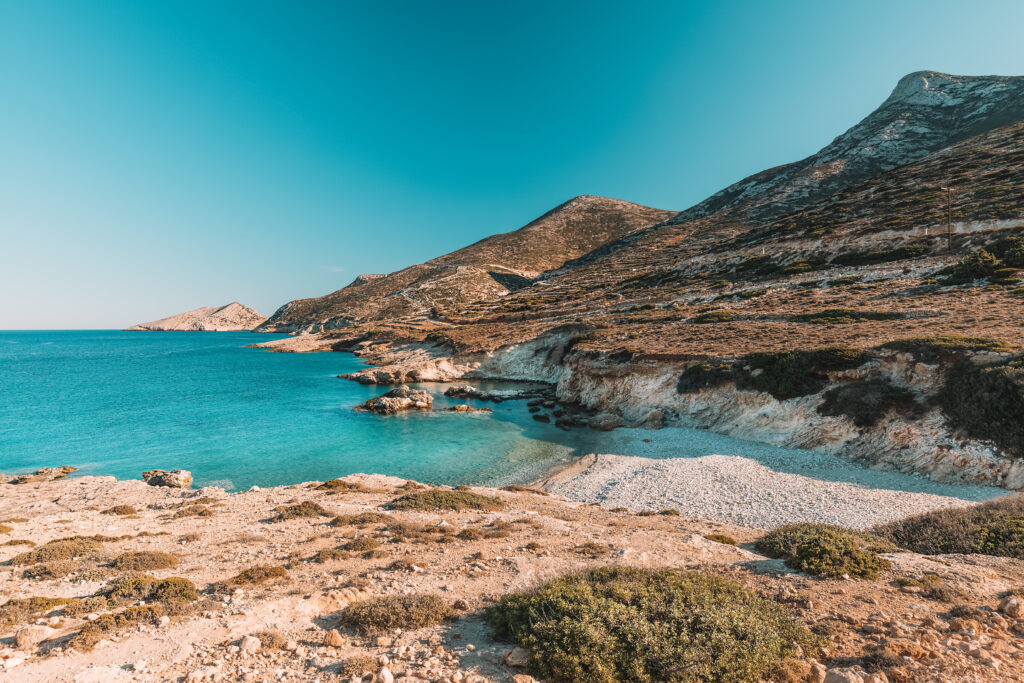
Kalotaritissa Beach
Beaches of Kalotaritissa
The enchanting bay near the village of Kalotaritissa has three lovely beaches. The small pebbly beach of Sapounohoma is the first one you will come across as you approach the village, while the second and largest one, Messa Ammos, is located just under the settlement of Kalotaritissa. At the left of the village, the beach known as Tripiti is the most beautiful one and can be accessed via a small path over the rocks. Although located to the north, they are all protected from the strong summertime meltemi winds by the islet Skoulonisi.

What to Eat in Donoussa
Despite the small number of main sources that the island produces, the local cuisine will impress you with its originality, its simplicity, and the local ingredients.
Here you will find the local versions of the savory Greek pie: tiropitaria, made with mizithra cheese, fresh milk, and mint, and hortopita, filled with a mix of chard, fennel, and onion. The local cheese palette includes firmani (filo-wrapped cheese with sesame and jam) and axialomizithra (made from strained yogurt and raki), which are served at almost every meal. And then there is the homemade pasta that the locals carefully store in glass jars: aranista (fermented wheat, known elsewhere in Greece as trachanas), klosta (homemade spaghetti), and pitaridia (long noodles cooked in milk).
Non-vegetarians should not leave the island without tasting its signature dish, patatato, comprised of goat meat cooked in tomato sauce and served with potatoes. Kavourmas (chunks of pork fried in lard) and yiaprakia (cabbage leaves stuffed with minced meat and rice) are perfect as appetizers.
Those with a sweet tooth also have something to look forward to: souvli (a favorite traditional pudding, made with wheat flour), xerotigana (fried dough strips with honey), pasteli (honey sesame bars), and prickly pear jam are all delicious and will leave you asking for more.
And since no meal is complete without the drinks, don’t forget to try the intensely aromatic sweet raki, made from dried figs, or the excellent semi-sweet red wine.
|Our Top Picks: Tzi Tzi in Mersini and Taverna Mitsos in Kalotaritissa



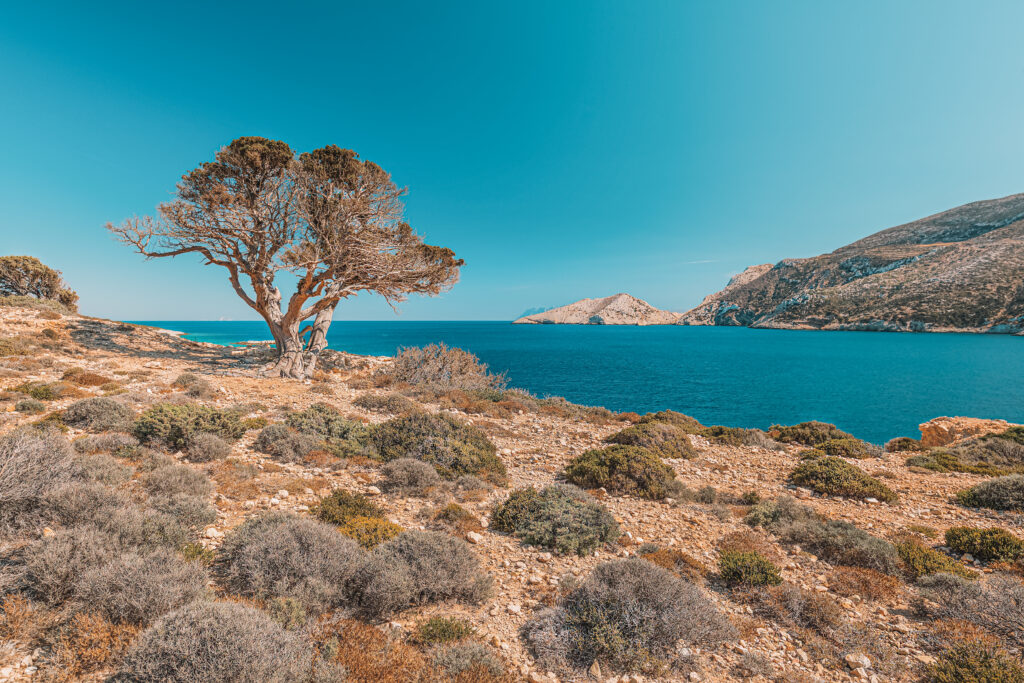
Hiking Trails in donoussa
Donoussa is a tiny hiking paradise, with paths and trails fragrant with the aroma of summer savory and rosemary. Its five marked hiking trails, used by locals since the old days, join together the island’s four settlements and pass by vintage mines, windmills, olive groves and vineyards. Throw on your hiking shoes and prepare to be awed!
Trail #1 – Stavros Village to Kalotaritissa Village
The most extensive of the island’s five trails starts from the village of Stavros and crosses the entire northern and northwestern side of the island before ending at the picturesque village of Kalotaritissa. It is arguably the most beautiful path and offers three detours, the most impressive of which is the one to Pappas, the island’s highest peak (387m).
|Distance: 4.4km | Total Time: 90min | Altitude: 268m | Difficulty: medium
Trail #2 – Kedros Beach to Messaria Village
The route starts at the beach of Kedros, from where it ascends in a Z form to a windy peak before unfolding smoothly to the settlement of Messaria, passing by the island’s old windmills.
|Distance: 1.1km | | Total Time: 30min | Altitude: 150m | Difficulty: easy
Trail #3 – Mersini Village to Livadi Beach
Quite steep in places and easy to descend but relatively tiring to climb, this trail connects the village of Mersini with the beautiful beach of Livadi, while an offshoot trail takes you to the secluded beach of Fikio.
|Distance: 0.9km | Total Time: 25min | Altitude: 162m | Difficulty: easy
Trail #4 – Kedros Beach to Lower Windmill:
Starting from the eastern side of Kedros beach, the trail follows the old route used by locals to transport migadi, a mixture of wheat and barley, to the Lower Windmill for milling.
|Distance: 1.8km | Total Time: 35min | Altitude: 80m | Difficulty: easy
Trail #5 – Stavros Village to Limni & Aspros Kavos:
The trail crosses the west side of the island and leads to a small natural bay called “Limni” and soon after to the cape Aspros Cavos, one of the most dramatic landscapes of the archipelago.
|Distance: 2.1km | Total Time: 40min | Altitude: 50m | Difficulty: easy


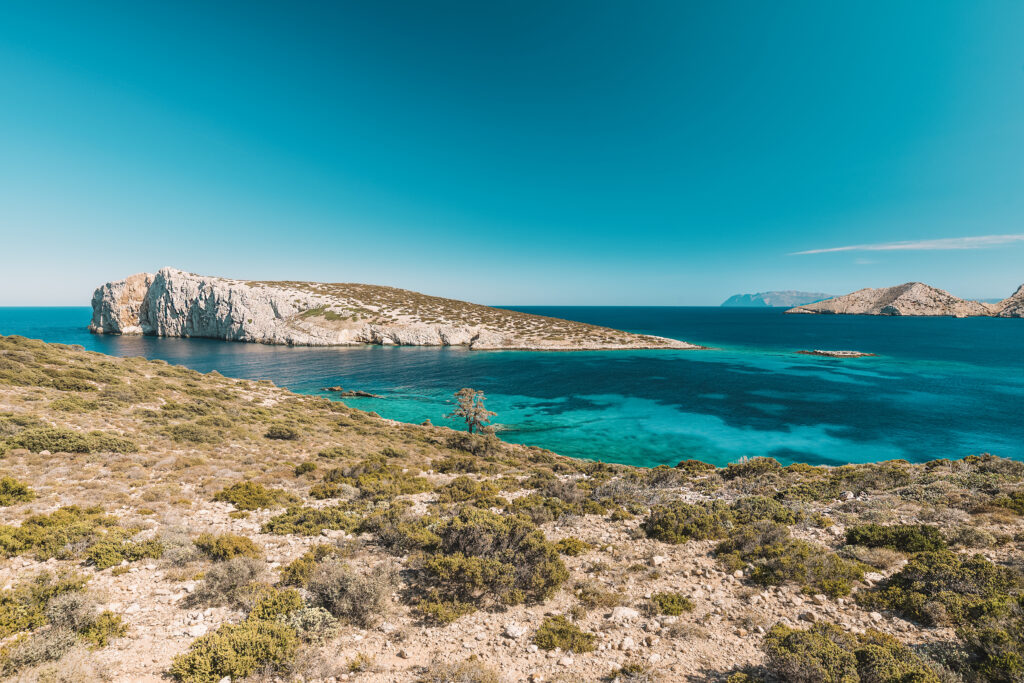
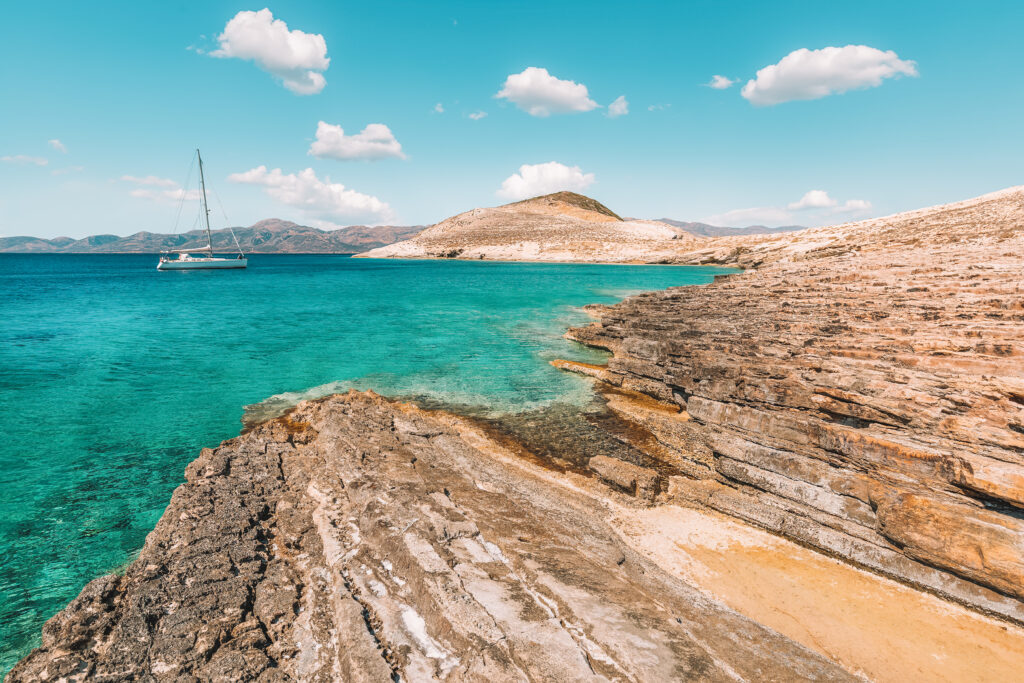

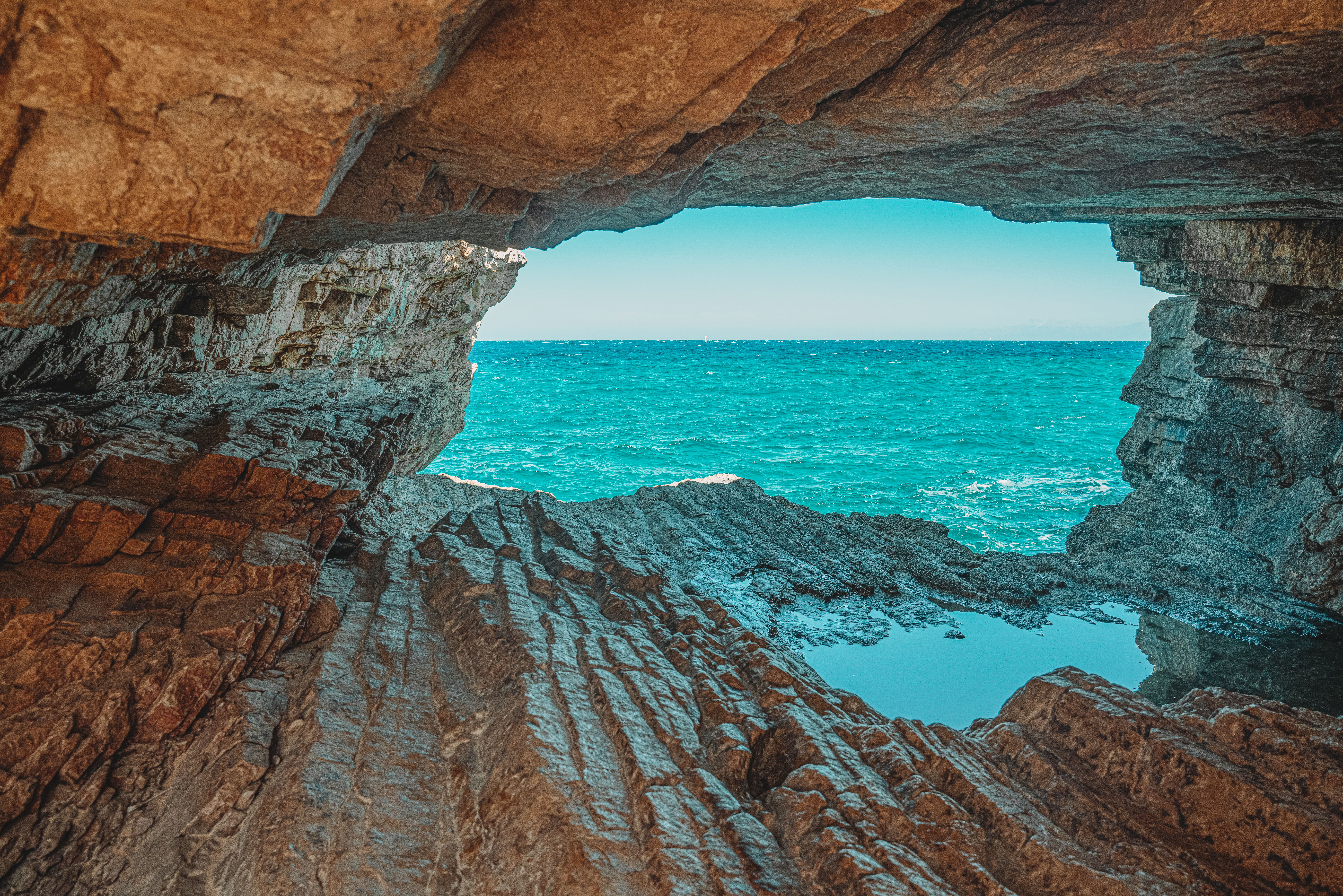
Day Trips & Island Hopping
From uninhabited islets to the off-the-beaten-track lesser Cyclades and the heavy-hitters, there is a hidden paradise for every island lover!
Islets around Donoussa
On special request and weather permitting, Captain Ilia’s “Donoussa Magissa” takes you to explore the exotic paradises of the rocky islets of Skoulonisi, Makares and Melantioi that surround Donoussa. Combine this trip with the caves Fokospilia and Tihos and discover untouched beaches and fantastic seas for diving and snorkeling.
Small Cyclades
Island-hopping in this chain of small, secluded islands calls to mind the Greek island experience of 20 years ago, when things moved slower and pleasures were simpler. The small local ferry Express Skopelitis connects Donoussa with Koufonissi, Schoinoussa, Iraklia 3 times per week all year round. The tickets are cheap (5-7€), the journey is short (1-2h) and the islands are paradise regained.
Other Islands around Donoussa
Paros, with its quaint villages. Naxos, the largest and most fertile of the Cyclades. Amorgos, with its dramatic mountain scenery and laid-back atmosphere. You can reach them all directly with the Blue Star Naxos ferry. And then there is Astypalaia, the butterfly-shaped island of the Dodecanese that would be more at home among the Cyclades.
